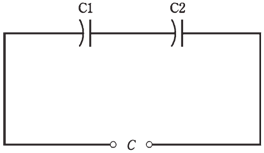Capacitors in series:
With capacitors, there is never any mutual interaction. This makes capacitors more easier to work with than the inductors.
Capacitors in series add together like the resistors in parallel. If you connect 2 capacitors of same value in series, result will be half capacitance of either component alone. Generally if there are many capacitors in series, the composite value is less than any single components. It is essential that you always use the same size units when determining the capacitance of any combination. Do not mix microfarads with the picofarads. The answer which you get will be in any size units you use for individual components.
Assume that you have several capacitors having values C1, C2, C3, . . . Cn all are connected in series. Then you can find reciprocal of total capacitance, 1/C, by using the following formula:
1/C = 1/C1 + 1/C2 + 1/C3 ... 1/Cn
The total capacitance, C, can be found by taking the reciprocal of number you get for 1/C.
If the two or more capacitors are connected in series, and one of them has a value which is extremely small compared with the values of all others, the composite capacitance can be taken as value of the smallest component.
Problem 1
Two capacitors, having values of C1= 0.10 µF and C2 = 0.050 µF, are connected in series. What is total capacitance present here?

Figure-- Capacitors in series.
Using above formula, 1st find the reciprocals of values. They are 1/C1=10 and 1/C2 = 20. Then 1/C = 10 +20 +30, and C = 1/30 =0.033 µF.
Problem 2
Two capacitors having values of 0.0010 µF and 100 pF are connected in the series. What is total capacitance?
Convert to same size units. A value of 100 pF depicts 0. 000100 µF. Then you can say that C1 0.0010 µF and C2 0.00010 µF. The reciprocals can be given as 1/C1 =1000 and 1/C2 = 10,000. Thus, 1/C = 1,000 + 10,000 = 11,000, and C = 0. 000091 µF. This number is a bit awkward, and you might rather say it is 91 pF.
In above problem, you could have opted pF to work with, instead of µF. In any of the case, there is some tricky decimal placement involved with it. It is important to double check the calculations when numbers get like this. The advanced calculators will take care of the decimal placement problem, at times using exponent notation and sometimes not, but a calculator can work with what you put into it! If you put a wrong number in, you will certainly get a wrong answer, off by a factor of 10, 100, or even 1,000.